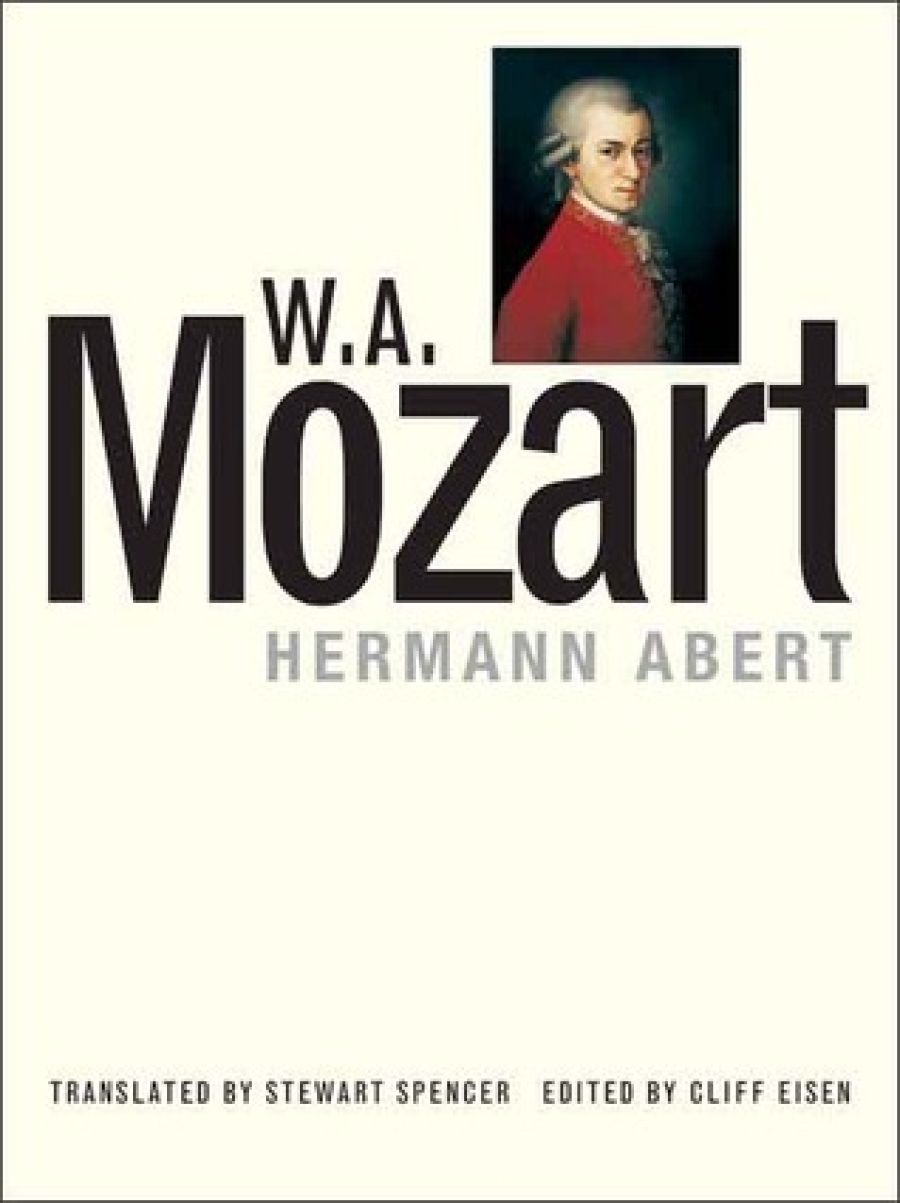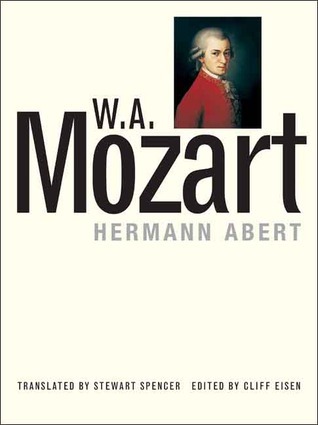
- Free Article: No
- Contents Category: Music
- Review Article: Yes
- Article Title: No compromise
- Online Only: No
- Custom Highlight Text:
It seems astonishing that one of the most important studies ever undertaken on Mozart should have taken almost eighty-five years to reach the English language. Hermann Abert’s monumental, and indeed famous, work was first published in 1924 and was originally intended as an updated edition to that other monumental work of Mozart scholarship undertaken by Otto Jahn, published in four volumes between 1855 and 1859.
- Book 1 Title: W. A. Mozart
- Book 1 Biblio: Yale University Press, $114.95 hb, 1515 pp
- Book 1 Cover Small (400 x 600):

- Book 1 Cover (800 x 1200):

The comprehensive nature of Abert’s work is encyclopedic. More than 1300 closely printed pages are devoted to an astonishingly detailed account of Mozart’s biography and, at least on the surface, pretty much all of his compositional output. Further, the text provides detailed accounts of Mozart’s musical influences, as well as accounts of all of his musical contemporaries, major and minor. There are complete essays on all of the operas – including sketches for operas that were never realised – providing detailed information on libretto sources, plot and each musical item contained within the operas, as well as hefty essays on more abstract musical matters relevant to Mozart’s creative processes, such as Gessellschaftsmusik, Opera Seria, Opera Buffa, Tragédie Lyrique, Gluck’s music dramas, Opéra Comique and German Singspiel. The examination of all areas of Mozart’s development, his output, his intellectual and artistic preoccupations, his personality – insofar as it can be gleaned from musical and extramusical sources – and what might be broadly called his habits of mind is little short of exhaustive. This sustained analysis of influences and the intellectual milieu which informed Mozart’s world really constitutes a text within a text.
Such comprehensive coverage comes with no compromise: this is not a tome for the faint-hearted or for the musically or linguistically uninformed. Music literacy is a prerequisite, as is a reasonable grasp of harmonic and formal analysis. The only illustrations in the entire work are musical quotations; not one single portrait is to be found other than the posthumous picture by Barbara Krafft, painted almost two decades after the composer’s death, which sits modestly in the upper corner of the cover. The linguistic demands of the text, translation notwithstanding, will certainly test the general presumption of monolingual English speakers. Most titles and a number of literary references remain firmly in their languages of origin – predominantly German but inevitably Italian and French, as well as Dutch, Spanish, Latin and others. A sound grasp of history and, more particularly, of the history of the evolution of cultural, intellectual and artistic movements in the eighteenth century, is assumed. This is all robustly challenging for the reader, though I doubt such faith in the sheer education of Abert’s readership would be as alienating for anyone who loves Mozart as this lack of intellectual compromise might sound.
Whilst Eisen’s view of Abert is clearly one of respectful and sustained admiration, there is one admitted area of disagreement which has already provoked commentary in the book’s critical reception, as well as informing Eisen’s attitude of mind to his task. In the substantial ‘Editorial Note’ which comes early in the text, Eisen takes issue with Abert’s view that ‘Mozart’s music expresses Mozart himself’. Eisen’s arguably more subtle perspective is that ‘what he expressed in his music was us, not himself’. Apart from arousing a lively, if finicky, exchange between Charles Rosen and Robert Marshall in the New York Review of Books late last year, Eisen’s broader and more existential view of Mozart’s creative core leads at least to rigorous, if tactful, corrections of fact, a consistent rejection of what sometimes emerges as Abert’s advocacy of anecdote – especially concerning Mozart’s last months – and a far more detailed and systematic approach to substantiation through extant sources, all often charmingly preceded by the anachronistic apology, ‘pace Abert’.
The Rosen–Marshall exchange also deals with other matters, one of which seems a major concern surrounding the book. In all of the extraordinary detailed discussion of what would have to be regarded by any sensible Mozartian as minor items of the composer’s output – the early liturgical works, for example – and for all the exhaustive account of every aspect of the operatic output, the piano concertos are treated with remarkable and inexplicable neglect, both in terms of the quantity of their treatment and the relative lack of analytic insight. Rosen ruefully remarks that Abert ‘does not trace the extraordinary change in the style of the concertos from the A Major K. 414 to the C Minor K. 491’, and singles out the failure to discuss the stunning originality of that early masterpiece, K.271 in E flat major, where the soloist’s trumpeting entry literally interrupts the orchestra after six notes, thereby prefiguring a compositional approach that will influence piano concertos as diverse as Beethoven Fourth, Brahms Second and Rachmaninov Second.
This lack of preoccupation with an output many would certainly place on a par with the operas simply baffled and disappointed me. I searched in vain for insights on the ethereal charm of K. 459 in F Major – which barely rates any mention at all – just as I waited expectantly for analysis of that incomparable Siciliana which is the slow movement of K. 488 in A, where astonishing woodwind sonorities support the piano’s poignant line. Such lacunae are no quibble, and it seems a significant drawback that a text so massively preoccupied with a long examination of developmental output should have neglected to examine adequately the very genre most intimately associated with Mozart’s own instrumental prowess.
There is one other problem with this text that I, as a musician who has loved and performed Mozart passionately for almost half a century, simply could not get around. Despite all of Abert’s and Eisen’s at times intimidating erudition, there is something cold at the core of this massive compilation of scholarship. Compositional, intellectual and personal influences are traced and analysed meticulously, and most of Mozart’s output is poured over in almost anatomically obsessive detail. It would seem that, partly because of the book’s overwhelmingly scholastic architecture, the sheer humanity of Mozart is largely bypassed. My own great teacher, and one of the most wondrous performers of Mozart who ever lived, Géza Anda, observed that with one eye Mozart smiles and with the other he weeps. It would be difficult to know this from the way Abert writes. His is a text which primarily and most thoroughly situates Mozart within his creative epoch, but it does not really embark on the much more complex task of explaining why Mozart’s music is so enduring and so fundamentally important to our species.
Of course, it is arguable that I am expecting something that so hardcore a musicological approach as Abert’s simply does not do. Such intellectual gestures as explication and analysis can only go so far in the world of music, which is why musicians have so often held the view that the highest critical task in music is the act of performance itself. Nonetheless, there certainly has been one musicologist who wrote about Mozart with extraordinary insight and humanity and in whose hands Mozart – man and legacy – come to life with intimate understanding and compassion. That is why, when somewhat exhausted by months of ingestion of Abert’s magnificent tome I still returned to that much slimmer volume published about twenty years after Abert’s first appeared, Alfred Einstein’s Mozart: His Character, His Work (1945).


Comments powered by CComment